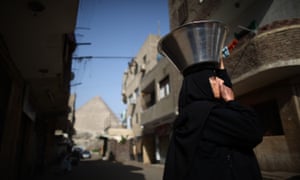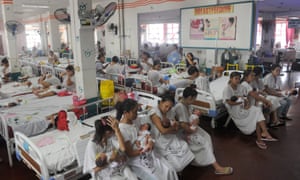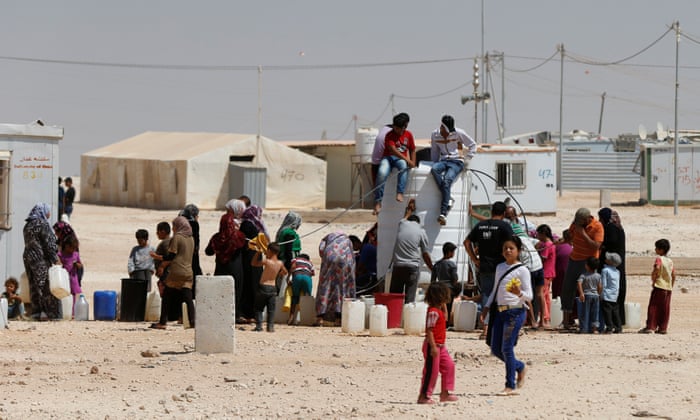
Carolyn Beans is a freelance science journalist living in Washington, D.C. She specializes in ecology, evolution and health.
In Washington, D.C., Peter Rabbit regularly challenges me to stop wasting food. On a billboard hovering beyond my local grocery store and on posters on bus stop shelters, he casually chomps on a carrot while leaning on big bold letters: "Better Ate Than Never."
Food waste estimates vary, but according to the Natural Resources Defense Council, which runs this national "Save the Food" campaign with the nonprofit Ad Council, up to 40 percent of food in America is lost each year. Producing this food requires up to about one-fifth of U.S. croplands, fertilizers and agricultural water. Once tossed, food becomes the No. 1 contributor, by weight, to U.S. landfills, where it releases methane, a greenhouse gas, while decaying.
Food is wasted across the supply chain — from farms to manufacturers to supermarkets to restaurants. But more than 40 percent of food loss comes from our own homes. According to the USDA, nearly 300 pounds of food per person goes uneaten in American homes each year, costing a family of four around $1,500.
Under Peter Rabbit's watchful gaze, it's getting harder to ignore my four-person family's contribution to this problem. I vow to do better each time I toss rubbery celery or fuzzy jam. But my guilt quickly turns to relief that the offensive food is no longer lurking, and the cycle continues.
"Patterns that contribute to food waste are often bound up in good intentions," JoAnne Berkenkamp, a senior advocate with NRDC, says. "We tend to be aspirational shoppers. We have a big cart. We want to fill it with healthy things. We want to make sure we don't run out."
To finally face my food waste, I weighed all of the food that my family threw away from May through July. I only weighed food that we intended to eat but didn't, so waste like chicken bones and banana peels didn't count.
Factors in my favor: access to NRDC's food saving tips and a spouse who, abhorring food waste, concocts culinary wonders with lifeless produce. Factors not in my favor: my unfounded fear of venturing beyond "best by" dates, a 3-year-old with an unpredictable appetite, and a 1-year-old with a serious food-throwing habit.
Through experimentation and experts' advice, here's what I learned during my family's three-month food waste challenge:
Meal plan (with high hopes and low expectations)
Planning out meals for the week is one of the most surefire ways to reduce excess food purchases. "Once you start getting into the rhythm of planning, that well-intentioned purchase of fish or chicken doesn't turn up green in the back of the fridge two weeks later," says agricultural economist Brian Roe of Ohio State University.
I've been a meal planner for years, but this experiment made me realize that I rarely follow through. Come Thursday, I'm often too tired to cook or too tempted by a dinner invitation to eat Monday night's leftovers. So I've started planning for late-week meals that may not happen. I drop leftovers in the freezer and decide on Wednesday whether they'll make another appearance that week. Or if I intend to cook, I make sure that whatever ingredients I purchase can handle extra fridge time.
Learn food waste patterns
"Once you understand your own patterns, you can get on top of it and change," says Berkenkamp. She realized that she often buys too much food before leaving town. I discovered that starchy food is my downfall. I always want more rice, french fries and pasta than I can eat. I started preparing smaller portions. And whenever french fries came with a sandwich at the food trucks by my office, I asked for half the typical serving. I paid the same for less food, but since I likely would have tossed half of the fries anyway, I didn't mind.
Start toddlers with smaller portions

I tried to learn which foods my youngest would hurl from his high chair, but one day's favorite was the next day's flying object. The NRDC suggests starting kids off with smaller portions, along with many other helpful tips on wasting less food with kids. I learned to offer a quarter of what I thought he'd eat, and then more when the coast was clear. Mostly this worked well, but 15 percent of our waste was still spoiled milk, largely from his sippy cup.
As for my older son, he was more excited to eat when I let him mix batter or pick vegetables from our garden. "We need to get better at connecting our kids to their food," says food waste consultant Jonathan Bloom, author of the book American Wasteland. "If they have a role in growing, purchasing or even cooking what's on their plate, they'll have more respect for what a beautiful thing food can be."
Stray from recipes
Because of the way fresh herbs are packaged, we almost always need to buy more than a recipe calls for. I threw away portions of five packages of herbs during this experiment. By the end, I found myself considering whether that teaspoon of fresh thyme was really necessary or whether I could swap in dried thyme or a sprig of rosemary I had lying around.
I also started substituting other ingredients. I planned a green beans and tofu disharound tofu that was nearing its "use by" date. There were no green beans at our farmers market, so I bought sweet peppers and sliced them long and thin, and julienned carrots that I already had at home.
The more adventurous can forgo recipes, letting leftovers lead. My husband can work magic with a partially used can of chipotle peppers in adobo sauce — smoky bean dip, fiery pizza sauce, spicy egg scrambles.
Know when food is actually spoiled
Many a good food gets tossed because it's beyond the "sell by" date. But as NPR has reported, those dates have less to do with safety than with the manufacturer's understanding of when the food's flavor becomes less optimal. Instead, give food the sniff test. If it smells funny, don't eat it.
Even armed with this information and the NRDC's tips for reviving food, I've been an adherent to "sell by" dates for so long that it was hard to ignore them. But I made progress. I turned mustard, two months past its expiration date, into a honey mustard vinaigrette. And I've pushed produce limits. Turns out that a slightly rubbery cucumber tastes like, well, a cucumber.
I've also tried to get better at predicting when opened food products will pass their prime. After I let jarred salsa verde spoil in my refrigerator not once but twice, I decided it was time to adjust my expectation of how long an open jar of salsa should last. I consulted the FoodKeeper App, which tells you how long a product will stay fresh in a pantry or refrigerator before and after being opened. For an opened jar of salsa in the refrigerator, it's a month. I went a week too long.
Guilt is not enough for change
"People do have general guilt about wasting food," says Roe. He and then-graduate student Danyi Qi, now an agricultural economist at Louisiana State University, conducted a national survey that found that over 75 percent of respondents either somewhat or strongly agreed that they feel guilty when throwing away food. But people also tend to think that their own contributions to food waste are no worse than anyone else's. Only about 14 percent of respondents felt that their households wasted more food than households of similar size.

While I've long felt guilty about food waste, it wasn't until I studied my food waste habits that I developed steps to change them. But studying personal food waste need not involve a kitchen scale. Berkenkamp simply stops and looks at food before throwing it away. "I ask myself, 'What am I throwing out? Why?' " she says. Bloom says composting has helped him. "In addition to recycling food's nutrients," he says, "it forces you to notice the types and amounts of food you're not using."
Learn from blunders
Over three months, my family threw away 10,553 grams of food, or about 23 pounds. I plotted our daily food waste, hoping to see a downward trend. Instead, I saw a series of peaks and valleys. My new goal, although I'm no longer weighing waste, is to push these peaks farther apart. I'll try my best to get to strawberries before the mold does. And I'll plan meals better before vacations.
I dedicated about 30 minutes each Saturday to meal planning. But my mind also frequently wandered to questions like, "How am I going to use up that half of a cup of ricotta?" As the experiment progressed, I spent more time thinking about reducing waste. It became less of a chore than a habit — one that saves money, leads to new recipes, and makes at least some dent in my family's ecological footprint. Plus, when I pass those Peter Rabbit posters, I can now look the bunny in the eye.
From NPR








